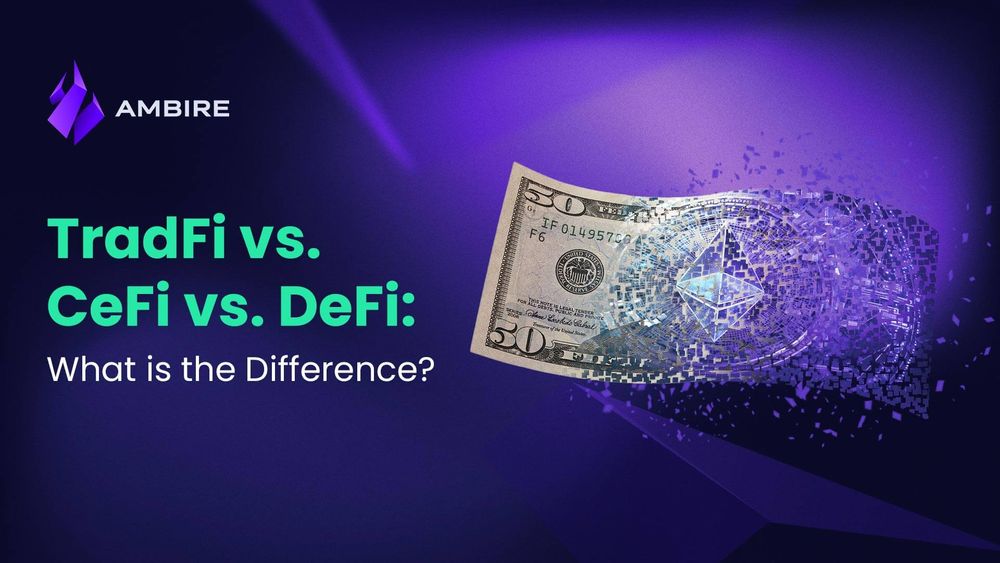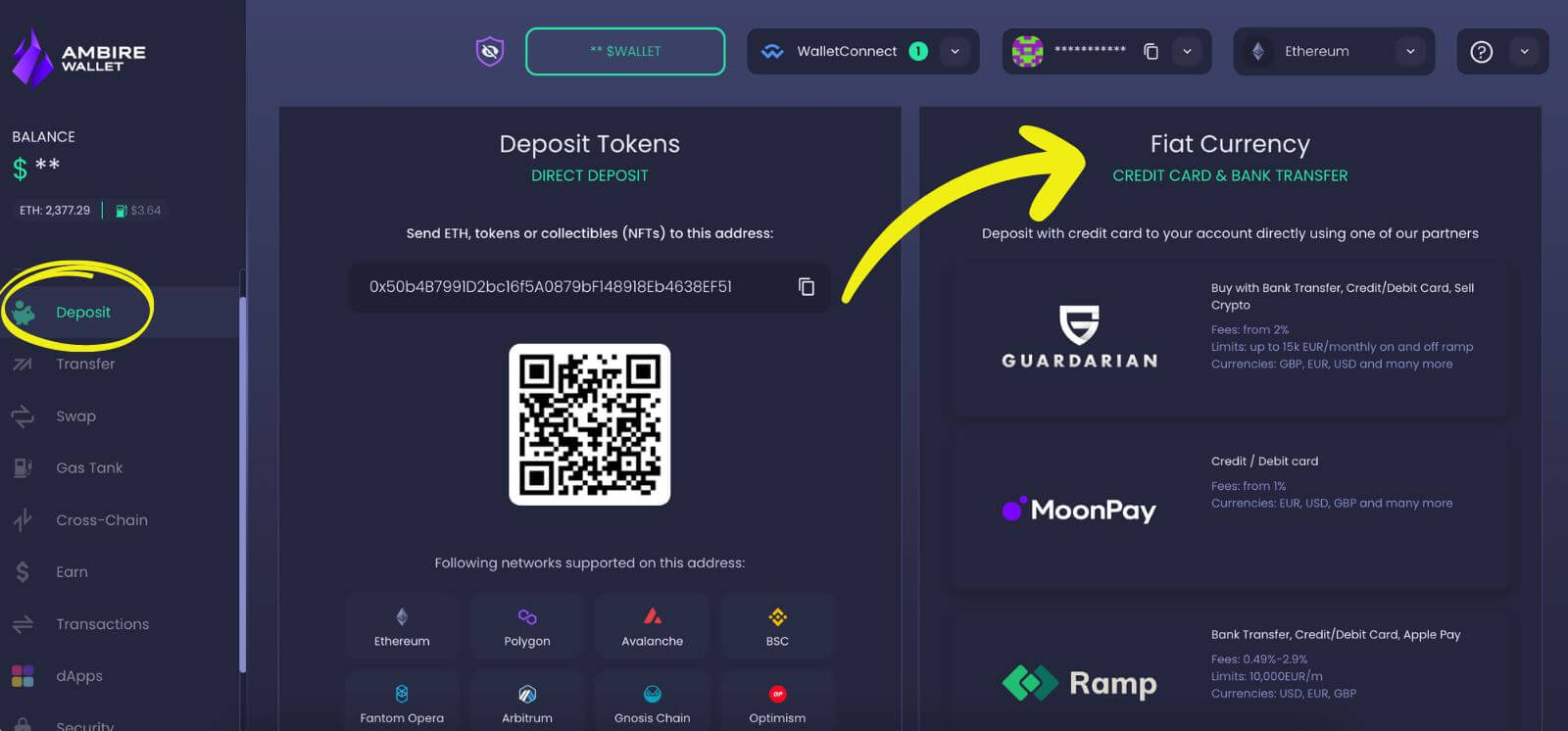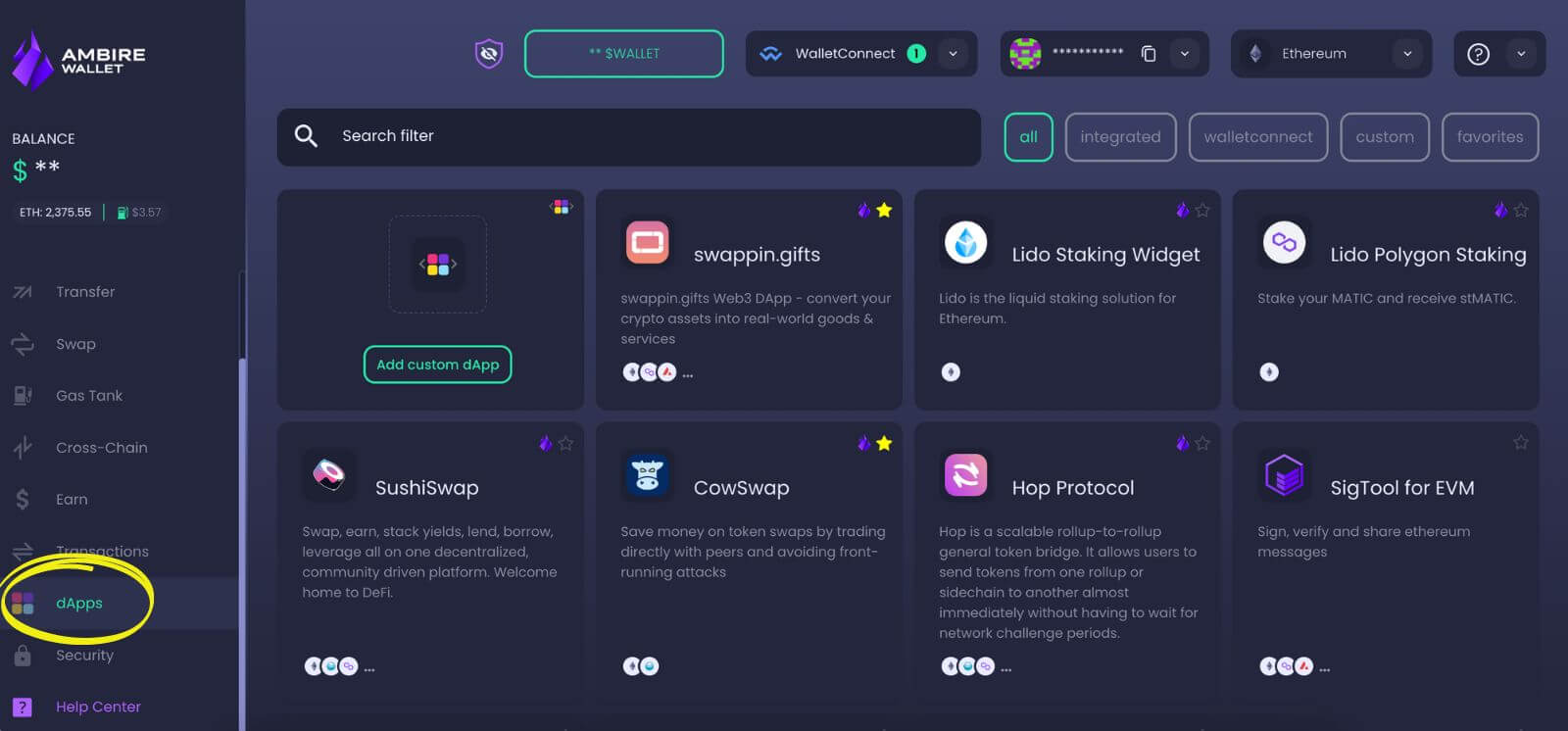TradFi vs. CeFi vs. DeFi: What is the Difference?
Grasp the essence of TradFi, CeFi, and DeFi. Learn how Ambire Wallet merges these financial realms, offering a robust, secure, efficient, and versatile digital asset management platform.

You may have seen acronyms like CeFi, DeFi, and TradFi floating on social media or other media outlets, but what do they mean? Understanding the distinctions between Traditional Finance (TradFi), Centralized Finance (CeFi), and Decentralized Finance (DeFi) has become essential in today’s digital economy. In this article, we'll dissect these three pillars of finance, showcasing how each operates and interacts with each other. As we explore these financial models, we'll highlight how Ambire Wallet, a cutting-edge smart contract wallet, navigates and innovates within this dynamic financial ecosystem, providing an understandable guide to modern financial infrastructure.
What is TradFi (Traditional Finance)?
Traditional Finance (TradFi) refers to the conventional financial ecosystem encompassing established banking institutions, insurance companies, stock exchanges, and other financial entities operating under a centralized governance model. This system, characterized by its rigorous regulatory frameworks and intermediaries like banks, has been pivotal in shaping the global economy, offering stability, trust, and various financial services.
TradFi operates on principles of centralization, where transactions are overseen and validated by trusted entities, ensuring security and adherence to legal standards. The services offered within this domain include savings accounts, loans, mortgages, and other financial products that have been the cornerstone of personal and corporate finance for centuries.
Ambire Wallet's connection to TradFi
While Ambire Wallet represents the cutting edge of blockchain, it recognizes the enduring importance of TradFi. To bridge the gap between the digital and traditional financial worlds, we integrate on- and off-ramps, providing seamless transitions between fiat (your regular money) and cryptocurrencies. They allow for buying and selling crypto in fiat.
Ambire Wallet has incorporated several ramps, each offering unique features to cater to the diverse needs of users: Guardarian, MoonPay, Ramp Network, and PayTrie. They support most major fiat currencies and cryptocurrencies, with fees starting as low as 0.6%. You can purchase cryptocurrency with Google Pay, Apple Pay, Revolut Pay, and almost any credit or debit card available. For crypto to fiat withdrawals, bank transfers are available as well.
For a detailed guide on using these on/off-ramps within Ambire Wallet, refer to our Web3 on/off-ramping guide.

What is CeFi (Centralized Finance)?
Centralized Finance (CeFi) represents the traditional financial system adapted to the digital age, acting as a bridge between Traditional Finance (TradFi) and Decentralized Finance (DeFi). CeFi platforms operate under a centralized authority, such as a company or organization, offering services similar to traditional banks but in the cryptocurrency space. These services include asset exchanges, loans, interest-bearing accounts, and more.
Key features of CeFi
- Lack of user control: In CeFi, users trust the platform to manage their assets. It’s similar to depositing money in a bank.
- Regulatory compliance: CeFi platforms often adhere to regulatory standards, performing identity checks (KYC) and following financial regulations.
- Intermediaries: Transactions and services in CeFi involve intermediaries, offering user support and dispute resolution but potentially adding to the cost and time.
- Security: While users must trust the platform's security measures, CeFi platforms usually have robust security protocols and insurance mechanisms.
Ambire Wallet recognizes the significance of CeFi and its role in the evolution of the crypto space, but we stay loyal to the self-custodial nature of cryptocurrencies.
By integrating with on-/off-ramp services, Ambire Wallet ensures users can smoothly transition between fiat and digital assets, enjoying the best of both worlds. The wallet's user-friendly interface, coupled with its commitment to security, makes it an ideal choice for users who appreciate the structured environment of CeFi while wanting to explore the broader potential of Web3.
What is DeFi (Decentralized Finance)?
Decentralized Finance (DeFi) represents a shift in the financial sector, leveraging the blockchain to eliminate intermediaries and empower individuals. DeFi platforms operate on principles of openness and inclusivity, providing a permissionless, transparent, and highly interoperable financial ecosystem. From lending and borrowing platforms to decentralized exchanges and innovative financial instruments, DeFi is reshaping the financial landscape.
Key features of DeFi
- Permissionless access: DeFi is open to everyone. Anyone with an internet connection can interact with DeFi platforms regardless of location or background, making financial services more inclusive.
- Powered by smart contracts: At the heart of DeFi are self-executing smart contracts with the terms directly written into code. These automated agreements facilitate trustless and transparent transactions.
- Interoperability and composability: DeFi protocols are designed to integrate seamlessly, allowing users to combine multiple services and products for a customized financial experience.
- Innovative financial instruments: DeFi introduces groundbreaking financial services, such as staking, yield farming, liquidity mining, and algorithmic trading, providing users unprecedented opportunities to manage and grow their assets.
Ambire Wallet is not just compatible with the DeFi ecosystem; it's a driving force within it. Let's put it this way: you need a Web3 wallet to experience the decentralized world of finance, and Ambire Wallet is the gateway to it, offering a next-generation wallet experience.
Features like advanced security options, eased transfer fee management, on/off ramps, built-in swapping functionality, and a dApp catalog make Ambire Wallet a leader in the DeFi space. The wallet's intuitive design and innovative functionalities align perfectly with the ethos of DeFi, providing users with a powerful yet user-friendly platform to engage with the decentralized financial world.

What's the difference between CeFi, DeFi, and TradFi?
TradFi, CeFi, and DeFi are distinct aspects of the financial ecosystem, each serving a different purpose and catering to different needs. Imagine TradFi as a traditional bank, CeFi as an online banking service with cryptocurrency features, and DeFi as a completely peer-to-peer version of financial services, each offering different levels of control, innovation, and regulatory interaction.
TradFi, the most established, operates through central authorities like banks and is characterized by stability and regulatory oversight but can be slower to innovate.
CeFi, a bridge between TradFi and DeFi, offers digital financial services similar to banks within the cryptocurrency world, providing user support and regulatory compliance.
DeFi, conversely, is a fully decentralized system running on the blockchain without central oversight. It's known for its inclusivity and innovative services like staking and yield farming.
When comparing CeFi and DeFi, they primarily differ in their approach to operations and governance. CeFi operates through centralized entities and offers a more traditional, regulated experience, while DeFi provides a permissionless, transparent, and highly interoperable environment. DeFi and cryptocurrencies were created as a whole, driven by a desire for more inclusive, efficient, and transparent financial systems, free from the constraints and often slow-moving nature of traditional financial and centralized digital financial systems.
The role of Ambire Wallet in the DeFi ecosystem
Ambire Wallet is not just a participant in the DeFI ecosystem; it's a pioneer, redefining how users store, manage, and interact with digital assets. Ambire Wallet introduces many features that enhance the user experience as a smart contract wallet.
Ambire Wallet allows users to simulate transactions before execution, previewing the outcome and cost. Additionally, transaction batching enables users to perform multiple transactions simultaneously, streamlining the process and saving on gas fees.
The unique Gas Tank feature allows users to pre-fund their transaction fees, ensuring smooth and uninterrupted wallet operations. It’s particularly beneficial in a high-traffic network environment, safeguarding users from fluctuating gas prices. Additionally, you do not require native tokens to pay for transaction fees, as Ambire lets you pay for these in stablecoins & other tokens.
Ambire Wallet provides a unified experience across different blockchain networks. Users can manage their assets on multiple chains through a single, consistent address, simplifying the management of portfolios.
Users can seamlessly exchange assets within and across different blockchains directly from their wallets. This feature enhances the flexibility of asset management and ensures that users can capitalize on opportunities across the evolving DeFi landscape.
Ambire Wallet leverages the power of smart contracts to offer advanced features such as enhanced security protocols, granular control over access and transactions, and the ability to recover accounts without traditional seed phrases.
By integrating these advanced functionalities, Ambire Wallet stands at the forefront of the financial revolution, bridging the gap between various financial systems and empowering users to navigate the complex landscape quickly and confidently.
Conclusion
In this exploration of TradFi, CeFi, and DeFi, we've unraveled the intricacies of the modern financial ecosystem. From the established stability of Traditional Finance to the innovative frontiers of Decentralized Finance, each system offers unique benefits and addresses specific user needs. Centralized Finance serves as a bridge, combining elements of traditional reliability with the efficiency and potential of digital assets.
Ambire Wallet emerges as a beacon in DeFi, harmonizing the strengths of TradFi, CeFi, and DeFi. By harnessing the power of smart contracts and integrating user-centric features, Ambire Wallet is not just adapting to the evolving financial paradigm—it's shaping it. With Ambire Wallet, users can confidently manage their assets across various financial systems, ensuring security, efficiency, and unparalleled convenience.
Interested in Ambire? Follow us:
Discord | X (Twitter) | Reddit | GitHub | Telegram | Facebook
